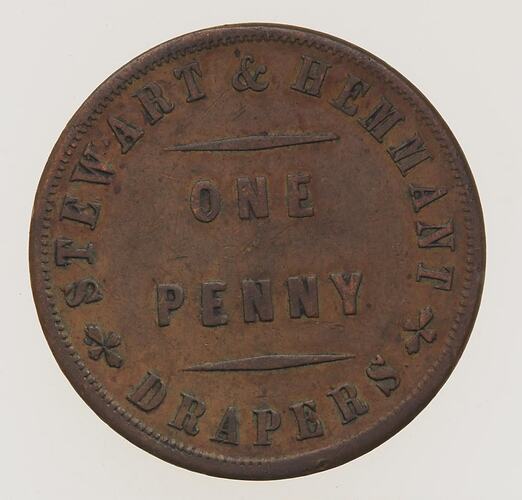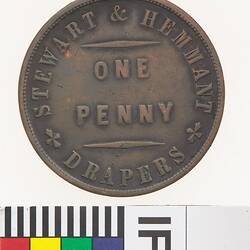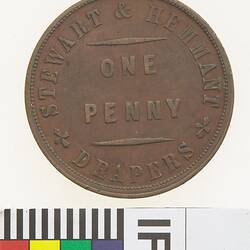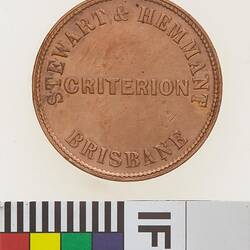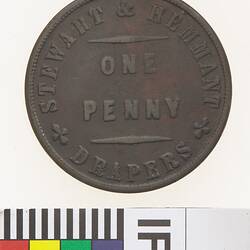Alexander Stewart and William Hemmant operated drapery businesses in Brisbane and Rockhampton between the 1860s and the 1890s. The Rockhampton store is still trading today (2005) as Stewart's Department Store.
While little is known of Stewart, Hemmant was a person of considerable significance in colonial Queensland. Born 10 October 1838 at Whittlesea, Cambridgeshire, England he came to Victoria in 1859 and worked as a miner at Ballarat for a short time. In 1860 he moved to Brisbane and established a drapery business with Alexander Stewart. Stewart and Hemmant's Queen Street, Brisbane store was burned to the ground in 1864, one of many businesses destroyed by a disastrous fire. Images relating to this fire are held by the Brisbane City Council. He visited England from 1865 to 1867, and while there married Lucy Elizabeth Ground. They had ten children. (ADB)
Hemmant was active in local and Colonial politics. He was a member of the Brisbane city council (1868-1870), held the colonial seats of South Moreton and Bulimba between 1871 and 1876, and served as Queensland's treasurer between June 1874 and 1876. According to the Australian Dictionary of Biography he was 'the most influential minister after McIlwraith' during his time as treasurer and his 'tariff policies introduced moderate protection in Queensland.' In 1876 he moved to London to act as agent for the drapery business, and as Commissioner for Queensland at several European exhibitions. He alleged corruption in the Queensland railways, but after a royal commission his accusations were found to have little substance. Between 1876 and 1916 he was a member of the board of the Australian Joint Stock Bank in London, making a significant contribution to that institution. He was commended for his service to the bank in 1911, for his role in transforming it into the Australasian Bank of Commerce. In 1885 he was Queensland's agent-general in England. William Hemmant died aged 78 on 20 September, 1916. (Australian Dictionary of Biography)
Stewart & Hemmant, Brisbane:
The company's main office in Brisbane was listed in Pugh's Directory in 1866 and their address was given as Queen Street.
An advertisement published in The Courier (Brisbane) of 6 March 1863 made an 'announcement extraordinary' about the 'great and unparalleled sensation! The Monster Bi-Annual Sale at the far-famed Criterion! Will open this day at 10 o'clock. Stewart and Hemmant have much gratification in announcing to 'AN ANXIOUSLY EXPECTANT PUBLIC' that their usual Half-Yearly Selling-off commences this day.' This style of advertising, known at the time as 'puffing', was commonly used by drapers. Drapers' enthusiastic announcements of fantastic savings on their goods were a staple of newspapers around Australia in the 1850s and 1860s. This advertisement is remarkable for its hyperbole. The declaration that 'By Particular Desire, revivification of the immortal SHILLING TABLE!! On which will be found a little 'WORLD IN MINIATURE' N.B. - This to be appreciated needs to be seen,' stands as an example of the kind of approach that the Bathurst, NSW firm Collins & Co. were trying to get away from when they headed their advertisement 'No Puffing'. On the same page, three other drapery businesses were also announcing the amazing savings to be had at their establishments.
On 14 March, Stewart and Hemmant inserted a smaller advertisement in the same paper, announcing the 'Last Day of the shilling table.'
Stewart and Hemmant also advertised in the main Queensland almanac of the time, Pugh's. The 1863 edition included an advertisement for Stewart & Hemmant's Brisbane Store immediately inside the front cover.
Stewart & Hemmant, Rockhampton:
In addition to their Brisbane store, Stewart and Hemmant opened a business in Rockhampton in 1862, soon after it was first occupied. Central Queensland historian Lorna McDonald gives the following description of the establishment and growth of the business in Rockhampton:
'James Stewart migrated to Australia in his twentieth year, having completed his apprenticeship in the drapery trade in Perth, Scotland. His lack of success on the Victorian gold-diggings prompted him to return to his own trade, first in Melbourne and then with his twin brother's [Alexander Stewart] firm in Brisbane - Hemmant & Stewart. In 1862 he was sent to open a branch in Rockhampton and did so in a shop owned by Surveyor A.F. Wood on the corner of Denham and Bolsover Streets. Despite much competition and a small population the business thrived and in mid 1864 Stewart moved the concern into the firm's newly built premises on the corner of East and Denham Streets 'with the largest stock yet offered to Rockhamptonites'. This was the first specialist drapery store in the town.' (McDonald)
The Rockhampton branch expanded strongly through the remainder of the nineteenth century. James Stewart bought out Hemmant's interest in the business in 1868, and took Edward Seymour Lucas 'who had been his chief assistant since 1863,' into partnership. The business traded as Stewart and Lucas until 1880, when Lucas opened his own store. The company was renamed 'John Stewart & Co.', under which it traded until it became a limited liability company in 1916. During the later decades of the nineteenth century Stewart's began manufacturing a range of goods, much as Melbourne retailers had done a couple of decades earlier as part of the founder's '.expansionist policy which took his retail drapery store into the manufacturing industry with factory departments turning out dresses, millinery, shirts, furniture and bedding. He also established branch stores in Mount Morgan, Blackall, Barcaldine and Longreach. By the mid 1920s three hundred people were employed at the Rockhampton headquarters alone, and there was a total shop and factory floor space of two and a half acres. Travelling salesmen served the needs of isolated families in the Central West, although an efficient mail order department and biannual catalogue later replaced this.' (McDonald)
Stewart and Hemmant issued three varieties of tokens. They were struck by W.J. Taylor of London, and are thought to have been issued c1860. The tokens mention both the Rockhampton and Brisbane Stores, so they must have been issued in 1862 at the earliest, and not later than 1868, when the Rockhampton store became a separate enterprise.
References:
Advertisement, The Courier, 6 March, 1863, p.4.
Advertisement, The Courier, 14 March, 1863.
Advertisement, Pugh's Queensland Almanac for 1863, Unnumbered page.
Advertisement, Pugh's Queensland Almanac for 1866, Unnumbered page.
McLeod, S. (1963). 'Notes on Rockhampton Token Issuers', The Report of the Numismatic Society of Australia, December, pp.98-99.
Personal Communication, Rockhampton City Council, 2005, 2 pps.
McDonald, Lorna (1981). Rockhampton: A History of City and District, pp.501-503.
Nairn, B., et. al., Australian Dictionary of Biography, Volume 4, 1851-1890, pp.375-376.
Unknown photographer. 'Queen Street during Bulcock's Fire.', 1864. Collection of Brisbane City Council Library. Call No.:BCC-B54-A464 http://www.brisbane.qld.gov.au/uhtbin/cgisirsi/lX8NaLlgVG/153180073/9, accessed 9 May 2005.
More Information
-
Keywords
-
Localities
-
Authors
-
Article types
